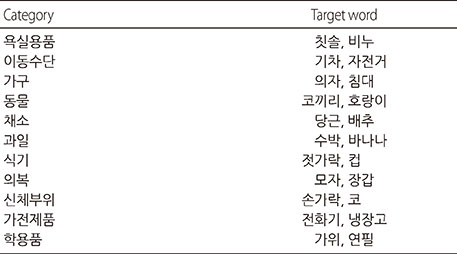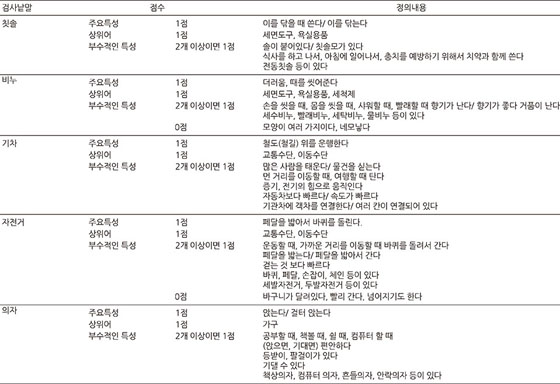Abstract
Background
The purposes of this study were (1) to investigate the abilities of word definition in patients with Alzheimer's disease (AD) according to the severity, and (2) to examine the error patterns in patients with Alzheimer's disease.
Methods
Eight individuals with MCI (CDR=0.5) and 16 patients with AD (eight for probable AD mild group of CDR=1 and eight for probable AD moderate group of CDR=2) participated in the study. Eight normal age-, gender-, and education-matched elderly adults served as a control group for the MCI and AD groups. As stimuli for the word definition, eleven semantic categories were used, and two concrete words were selected from each category, resulting in a total of 22 items. Prior to the task, four definition categories were provided: 1) functional, 2) relational, 3) perceptual, and 4) categorical. Statistical analyses were performed using Kruskal-Wallis test, and Bonferroni analyses were used as a post-hoc comparison for any significant results.
Results
There were significant differences in word definition scores among four groups. The probable AD moderate group showed the lower definition score than the probable AD mild group. And the probable AD moderate group showed the lower definition score than MCI group. Each group defined words in different ways. While the control group employed four definition different categories equally, the probable AD moderate group used a functional definition category mainly. However, relational and categorical definition categories were rarely observed in the probable AD moderate group. The analysis of error pattern showed that inadequate definition was frequently observed in all groups.
Figures and Tables
References
2. Bayles KA, Tomoeda CK, Trosset MW. Naming and categorical knowledge in Alzheimer's disease: the process of semantic memory deterioration. Brain Lang. 1990; 39:498–510.

3. Kim H, Kim EY, Na DL. Naming deficits in patients with dementia of the Alzheimer type: Error analysis of Korean version-Boston naming test. J Korean Neurol Assoc. 1997; 15:1012–1021.
5. Bayles KA. Effects of working memory deficits on the communicative functioning of Alzheimer's dementia patients. J Commun Disord. 2003; 36:209–219.

6. Astell AJ, Harley TA. Accessing semantic knowledge in dementia: evidence from a word definition task. Brain Lang. 2002; 82:312–326.

7. Hodges JR, Patterson K, Graham N, Dawson K. Naming and knowing in dementia of Alzheimer's type. Brain Lang. 1996; 54:302–325.

8. American Psychiatric Association (APA). Diagnostic and Statistical Manual of Mental Disorders (DSM-IV). 4th ed. Washington, DC: American Psychiatric Association;1994.
9. McKhann G, Drachman D, Folstein M, Katzman R, Price D, Stadlan EM. Clinical diagnosis of Alzheimer's disease: report of the NINCD-SADRDA Work Group under the auspices of Department of Health and Human Services Task Force on Alzheimer's disease. Neurology. 1984; 34:939–944.

10. Morris JC. The Clinical Dementia Rating (CDR): current version and scoring rules. Neurology. 1993; 43:2412–2414.
12. Kang Y, Na DL, Hahn SH. A validity study in the Korean mini-mental state examination (K-MMSE) in dementia patients. J Korean Neurol Assoc. 1997; 15:300–307.
13. Collins AM, Quillian MR. Experiments on semantic memory and language comprehension. New York: Wiley;1972.
14. Kim GH. Vocabulary for Korean language education by grade. Seoul: Pagijong Press;2003.
15. Cho NH. Reports on the usage frequency of modern Korean words: Preliminary study for a selection of vocabulary for Korean language education. Seoul: The National Institute of the Korean Language;2002.
16. Park KA. Comparison of Verbal Definitions of Concrete Nouns between Normal Children and Language-Delayed Children. Ewha Womans University;1999. Master's thesis.
17. Minjungseorim editorial deparment. Minjung's essence of Korean dictionary. Paju City: Minjungseorim Press;2006.
18. Yonsei Institute of Language and Information Studies. Yonsei Korean dictionary. Seoul: Doosan Dong-A Press;2007.
19. Doosan Dong-A editorial department. Dong-A new Korean dictionary. Seoul: Doosan Dong-A Press;2006.
20. Johnson CJ, Anglin JM. Qualitative developments in the content and form of children's definitions. J Speech Hear Res. 1995; 38:612–629.

21. Norlin PF. The development of relational arcs in the lexical semantic memory structures of young children. J Child Lang. 1981; 8:385–402.

22. Abeysinghe SC, Bayles KA, Trosset MW. Semantic memory deterioration in Alzheimer's subjects: evidence from word association, definition, and associate ranking tasks. J Speech Hear Res. 1990; 33:574–582.
23. Bayles KA. Effects of working memory deficits on the communicative functioning of Alzheimer's dementia patients. J Commun Disord. 2003; 36:209–219.

25. Hodges JR, Graham N, Patterson K. Charting the progression in semantic dementia: implications for the organization of semantic memory. Memory. 1995; 3:463–495.

26. Johnson DD, Tomsbronowski S, Pittelman SD. Vocabulary Development. Volta Rev. 1982; 84:11–24.
27. Yang DW. Mechanism of Memory and Disorders of Memory. Dement Neurocogn Disord. 2004; 3:65–72.
28. Collins AM, Loftus E. A spreading activation theory of semantic processing. Psychol Rev. 1975; 82:407–428.




 PDF
PDF ePub
ePub Citation
Citation Print
Print










 XML Download
XML Download